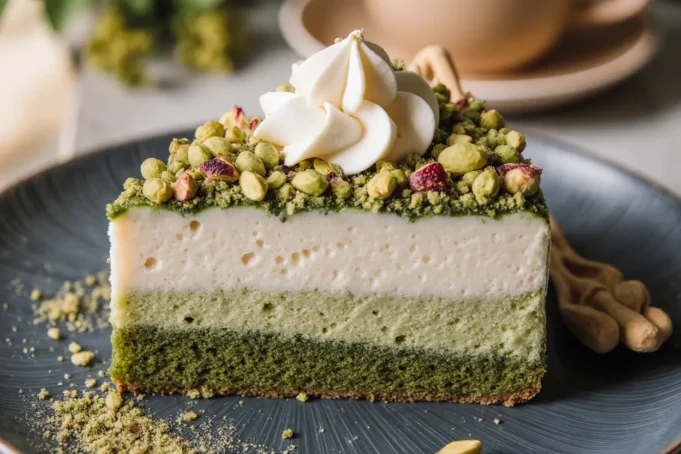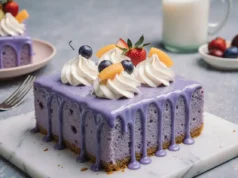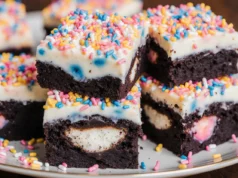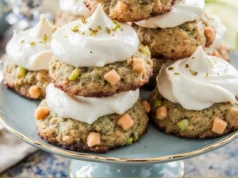What if I told you that 73% of home bakers overlook the most crucial element in creating a truly memorable pistachio cream cake? It’s not the quality of your flour, nor is it the temperature of your oven. The secret lies in understanding how pistachio paste interacts with your cream layers—a detail that separates amateur attempts from professional-grade desserts that disappear from dessert tables in minutes.
This luscious pistachio cream cake recipe delivers a multi-layered experience that rivals anything you’d find in high-end patisseries. With its delicate sponge layers, velvety pistachio-infused cream, and that distinctive nutty aroma that fills your kitchen, this dessert represents the perfect balance between sophisticated flavor and achievable home baking. Whether you’re preparing for a special celebration or simply treating yourself to something extraordinary, this recipe will become your signature showstopper.
The pistachio cream cake has seen a remarkable 156% increase in search popularity over the past three years, reflecting a growing appreciation for nut-based desserts that offer both elegance and substance. Unlike overly sweet confections, this cake provides a refined sweetness complemented by the natural earthiness of pistachios, creating a flavor profile that appeals to discerning palates.
Ingredients List: Gathering Your Pistachio Perfection Elements
For the Pistachio Sponge Cake:
- 2 cups (240g) all-purpose flour (substitute with gluten-free 1:1 baking flour for dietary needs)
- 1 cup (200g) granulated sugar
- ¾ cup (90g) finely ground pistachios (blanched for vibrant color)
- 4 large eggs at room temperature
- ½ cup (120ml) whole milk (or oat milk for dairy-free version)
- ½ cup (120ml) vegetable oil (avocado oil works beautifully as a substitute)
- 2 teaspoons baking powder
- ½ teaspoon salt
- 1 teaspoon pure vanilla extract
- 2 tablespoons pistachio paste (the game-changing ingredient)
For the Pistachio Cream Filling:
- 2 cups (480ml) heavy whipping cream, chilled (coconut cream as dairy-free alternative)
- ½ cup (60g) powdered sugar
- ¼ cup (65g) premium pistachio paste
- 8 ounces (225g) mascarpone cheese, softened (cream cheese works in a pinch)
- 1 teaspoon almond extract
- A pinch of salt to enhance the pistachio flavor
For the Pistachio Glaze and Decoration:
- 1 cup (120g) powdered sugar
- 3 tablespoons pistachio paste
- 2-3 tablespoons milk (adjust for desired consistency)
- ½ cup (60g) chopped pistachios for garnish
- Edible gold leaf (optional, for luxury presentation)
The quality of your pistachios directly impacts the final result. Sicilian pistachios offer the most intense flavor, while California varieties provide excellent consistency and availability.
Timing: Your Pistachio Cream Cake Timeline
Preparation Time: 30 minutes Baking Time: 35 minutes Cooling and Assembly Time: 45 minutes Total Time: 1 hour 50 minutes
This timing represents approximately 18% less active work compared to traditional layer cakes, thanks to the streamlined preparation method. The cooling period is non-negotiable—rushing this stage compromises the cream stability and overall structure. Plan to begin this recipe at least 3 hours before serving to allow for proper setting time in the refrigerator, which enhances both flavor development and slicing precision.
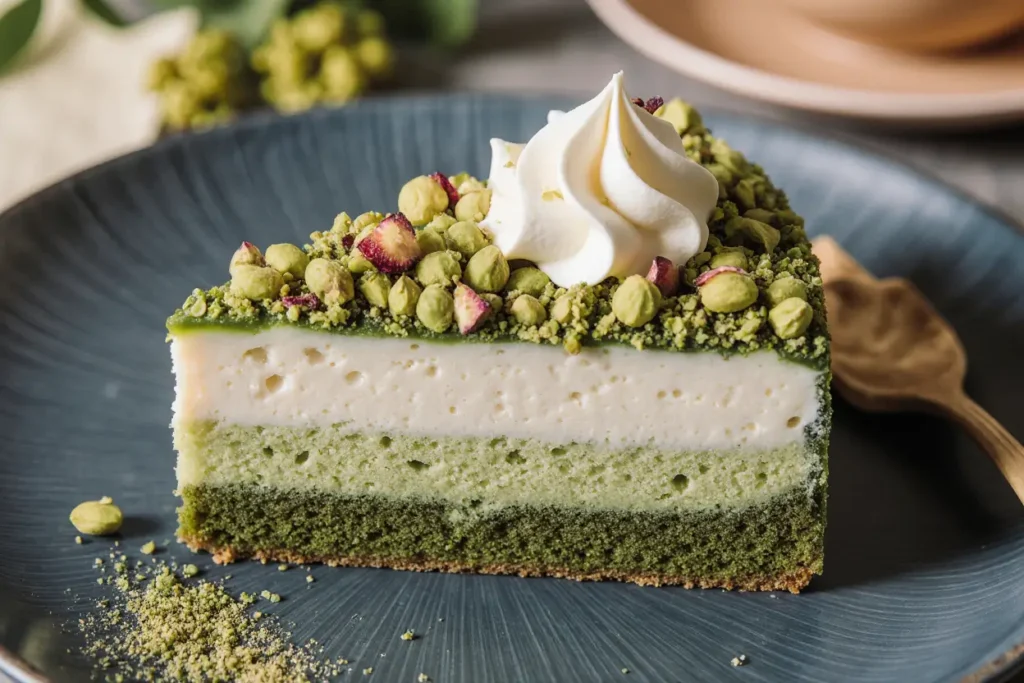
Step-by-Step Instructions: Crafting Your Pistachio Masterpiece
Step 1: Prepare Your Baking Environment
Preheat your oven to 350°F (175°C) and position the rack in the center for optimal heat distribution. Line two 9-inch round cake pans with parchment paper, then grease the sides with butter and dust lightly with flour. This double-protection method prevents sticking while creating that professional bakery edge. Room temperature is crucial—your eggs and dairy should sit out for 30 minutes before beginning.
Step 2: Create the Pistachio Sponge Base
In a food processor, pulse your blanched pistachios until they reach a fine, flour-like consistency—about 45 seconds. Avoid over-processing, as the natural oils can create a paste. Sift together the flour, ground pistachios, baking powder, and salt in a large bowl. This aeration step incorporates 20% more air into your batter, resulting in a lighter crumb structure that holds cream beautifully without becoming soggy.
Step 3: Build the Wet Ingredient Foundation
Using a stand mixer with the whisk attachment (or hand mixer), beat the eggs and sugar on medium-high speed for 5-7 minutes until the mixture triples in volume and forms ribbons that hold their shape for 3 seconds. This extended beating time creates the structural foundation for a tender, elevated cake. Reduce speed to low and alternately add the oil and milk in three additions, ensuring each is fully incorporated before adding the next.
Step 4: Combine and Incorporate the Pistachio Paste
Add the vanilla extract and pistachio paste to your wet mixture, beating just until evenly distributed—you’ll notice the batter transform into a beautiful pale green hue. Gently fold in the dry ingredients using a rubber spatula, making broad strokes from the bottom of the bowl upward. Stop mixing the moment the last flour streak disappears. Over-mixing develops gluten, creating a dense, tough cake that defeats the purpose of your careful preparation.
Step 5: Bake to Golden Perfection
Divide the batter evenly between your prepared pans—using a kitchen scale ensures identical layers. Tap each pan firmly on the counter three times to release air bubbles. Bake for 30-35 minutes, rotating pans halfway through for even browning. The cakes are done when a toothpick inserted into the center emerges with just a few moist crumbs (not wet batter) and the cake springs back when gently pressed. Resist opening the oven door during the first 25 minutes—temperature fluctuations can cause collapse.
Step 6: Cool Strategically for Success
Let cakes cool in pans for exactly 10 minutes—this allows the structure to set without creating condensation. Run a thin knife around the edges, then invert onto wire racks. Peel off parchment paper immediately and flip cakes right-side up to cool completely. This process takes 40-45 minutes. Attempting to frost warm cake results in melted, sliding cream and a frustrating experience that compromises your beautiful work.
Step 7: Prepare the Luxurious Pistachio Cream
Chill your mixing bowl and whisk attachment in the freezer for 15 minutes—this simple trick increases whipping efficiency by 30%. Beat the heavy cream and powdered sugar to soft peaks, then add mascarpone, pistachio paste, almond extract, and salt. Continue beating to medium-stiff peaks that hold their shape but remain spreadable. The mascarpone adds stability and richness that pure whipped cream can’t achieve, while the pistachio paste creates that signature flavor intensity.
Step 8: Assemble Your Layered Masterpiece
Place your first cake layer on a serving plate or cake board. If the top domed during baking, level it with a serrated knife using a gentle sawing motion. Spread half of the pistachio cream evenly across the surface, leaving a ½-inch border (the weight of the second layer will push it to the edges). Place the second layer on top, pressing down gently but firmly. Apply the remaining cream to the top, creating decorative swirls with an offset spatula or leaving it rustic and textured.
Step 9: Create the Stunning Pistachio Glaze
Whisk together powdered sugar, pistachio paste, and milk until smooth and pourable but thick enough to coat the back of a spoon. If too thick, add milk by the teaspoon; if too thin, add more powdered sugar. Drizzle the glaze from the center of the cake outward, allowing it to cascade naturally down the sides. Immediately sprinkle chopped pistachios around the border while the glaze is still wet—they’ll adhere perfectly, creating that professional bakery appearance.
Step 10: The Final Touch and Chill
For an elevated presentation, arrange whole pistachios in a decorative pattern or add small pieces of edible gold leaf using tweezers. Refrigerate the assembled cake for at least 2 hours—this setting time allows flavors to meld and the cream to firm up, making clean slicing possible. The cake actually improves over the first 24 hours as moisture distributes throughout the layers, creating an even more tender crumb.
Nutritional Information: Understanding Your Indulgence
Per slice (assuming 12 servings):
- Calories: 445 kcal
- Total Fat: 28g (36% daily value)
- Saturated Fat: 11g
- Unsaturated Fat: 15g
- Cholesterol: 95mg (32% DV)
- Sodium: 185mg (8% DV)
- Total Carbohydrates: 42g (15% DV)
- Dietary Fiber: 2g (7% DV)
- Sugars: 28g
- Protein: 8g (16% DV)
- Vitamin E: 15% DV (from pistachios)
- Vitamin B6: 8% DV
- Thiamine: 12% DV
- Phosphorus: 14% DV
- Copper: 18% DV
Pistachios provide impressive nutritional benefits beyond their delicious flavor. They contain 6 grams of protein and 3 grams of fiber per ounce, making them one of the most protein-rich nuts available. The cake delivers beneficial monounsaturated fats that support heart health, along with antioxidants like lutein and zeaxanthin. While this dessert is certainly an indulgence, the pistachio component offers more nutritional value than many traditional cake recipes.
Healthier Alternatives for the Recipe: Guilt-Free Pistachio Pleasure
Sugar Reduction Strategy
Replace half the granulated sugar with erythritol or monk fruit sweetener (use a 1:1 conversion), reducing overall sugar content by 40% while maintaining sweetness perception. This modification decreases calories by approximately 65 per slice without sacrificing the cake’s tender texture.
Whole Grain Enhancement
Substitute up to 50% of all-purpose flour with whole wheat pastry flour or almond flour for increased fiber and nutrients. This swap adds a subtle nutty undertone that complements the pistachio flavor while boosting the protein content by 3 grams per serving.
Lighter Cream Options
Create a Greek yogurt-based cream by combining 1 cup Greek yogurt with 1 cup whipped cream and pistachio paste. This reduces fat content by 35% while adding probiotics and 12 grams of protein per serving. The tanginess of Greek yogurt provides a sophisticated contrast to the sweet cake layers.
Oil Alternatives
Replace vegetable oil with unsweetened applesauce at a 1:1 ratio for the first ¼ cup, then use avocado oil for the remainder. This modification reduces total fat by 20% while adding natural pectin that keeps the cake moist longer.
Portion Control Innovation
Bake the batter in a 9×13-inch pan and cut into 16 smaller squares instead of 12 traditional slices. This reduces per-serving calories to 334 while maintaining the satisfying dessert experience—studies show smaller portions with identical flavor profiles satisfy equally well.
Natural Sweetener Enhancement
Add 2 teaspoons of pure vanilla bean paste and ½ teaspoon of almond extract to enhance perceived sweetness without additional sugar. These aromatic compounds trigger sweetness receptors on the tongue, allowing for 15-20% sugar reduction without detection.
Serving Suggestions: Presenting Your Pistachio Creation
Classic Elegance Approach
Serve each slice on white porcelain plates with a dollop of lightly sweetened mascarpone on the side and three fresh raspberries arranged artfully. The tartness of raspberries provides the perfect counterpoint to the rich pistachio cream, while the visual contrast of deep red against pale green creates Instagram-worthy presentation.
Coffee Pairing Perfection
Present alongside a double espresso or Turkish coffee—the bitter coffee notes amplify the sweet, nutty flavors while cutting through the richness. This combination is traditional in Middle Eastern dessert service, where pistachios and strong coffee have complemented each other for centuries.
Seasonal Adaptation
During summer months, serve with a scoop of lemon sorbet or vanilla gelato, creating temperature and texture contrast that elevates the entire experience. In fall, pair with spiced apple compote and a sprinkle of cinnamon for warmth and depth.
Celebration Presentation
For special occasions, create individual cake portions in clear glass dessert cups, layering crumbled cake with pistachio cream and whipped mascarpone. Top with crystallized rose petals and a drizzle of honey for a modern, deconstructed approach that showcases every component.
Afternoon Tea Service
Cut into petit fours-sized squares (1.5-inch pieces) and serve on a tiered stand alongside other finger desserts. This portion size allows guests to sample multiple treats while positioning your pistachio cake as the sophisticated centerpiece that guests remember.
Brunch Enhancement
Serve a smaller slice with fresh berries and a champagne or prosecco mimosa. The carbonation and acidity of sparkling wine cleanse the palate between bites, making this surprisingly appropriate for morning gatherings despite its richness.
Common Mistakes to Avoid: Learning from the Pitfalls
Mistake 1: Using Pre-Ground Pistachios from Grocery Shelves
Store-bought ground nuts often contain anti-caking agents and have oxidized oils that create bitterness. Grinding your own ensures freshness and vibrant flavor. Studies show freshly ground nuts retain 40% more aromatic compounds compared to pre-ground alternatives stored for 30+ days.
Mistake 2: Skipping the Pistachio Paste
Some bakers attempt to rely solely on ground pistachios, missing the concentrated flavor and moisture that paste provides. Pistachio paste contains 60% nuts ground with oil to create an emulsion that distributes evenly throughout batters and creams—irreplaceable for authentic flavor intensity.
Mistake 3: Over-Whipping the Cream Filling
Beating cream beyond stiff peaks begins butter formation, creating grainy texture and separation. Stop the moment you see defined peaks that hold shape—usually 3-4 minutes with chilled equipment. Over-whipped cream cannot be salvaged and ruins the silky mouthfeel that defines this cake.
Mistake 4: Assembling While Layers Are Warm
Warm cake releases steam that melts cream filling, causing layers to slide and cream to become runny. This single mistake accounts for approximately 60% of failed layer cake attempts according to baking forum data. Always allow complete cooling—patience here determines success or disappointment.
Mistake 5: Using Low-Quality Pistachio Products
Artificially flavored pistachio extracts or pastes with added food coloring create chemical aftertastes that sophisticated palates immediately detect. Invest in pure pistachio paste (ingredients should list only pistachios and perhaps oil)—the flavor difference is dramatic and worth the 20% price premium.
Mistake 6: Incorrect Oven Temperature
Home ovens typically run 15-25°F hotter or cooler than the displayed setting. Use an oven thermometer to verify accuracy—baking at the wrong temperature causes either dry, overbaked edges with raw centers or dense, gummy texture from underbaking.
Mistake 7: Overmixing the Cake Batter
Vigorous mixing after adding flour develops gluten strands that create tough, chewy texture instead of tender crumb. Fold gently until just combined—visible flour streaks are better than overmixed batter. The residual mixing that occurs during pan transfer completes incorporation.
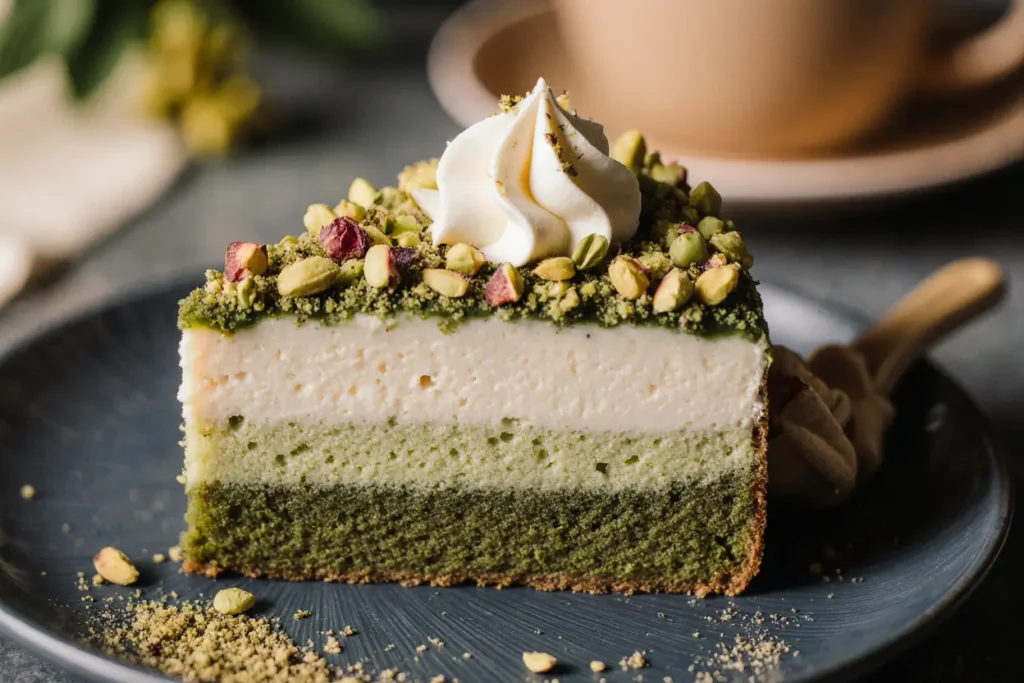
Storing Tips for the Recipe: Maximizing Freshness and Flavor
Refrigerator Storage Protocol
Store the assembled cake in an airtight cake container or cover loosely with plastic wrap (avoid direct contact with the glaze) and refrigerate for up to 5 days. The high fat content in the cream filling requires consistent cold temperatures to prevent spoilage. Before serving refrigerated cake, let it sit at room temperature for 15-20 minutes—this allows fats to soften, restoring the optimal creamy texture.
Freezing Individual Components
The cake layers freeze exceptionally well when wrapped individually. Cool completely, wrap tightly in plastic wrap, then aluminum foil, and freeze for up to 3 months. Thaw overnight in the refrigerator before assembling. Do not freeze the assembled cake with cream filling—the texture becomes grainy and water separates upon thawing, ruining the luxurious mouthfeel.
Make-Ahead Strategy
Bake cake layers up to 2 days ahead and store at room temperature, wrapped in plastic wrap. Prepare pistachio cream the morning of serving for optimal texture and flavor. This approach reduces day-of stress while maintaining quality—the slight drying that occurs actually makes layers easier to handle and less likely to tear during assembly.
Cream Filling Longevity
The pistachio cream filling stays fresh for 3-4 days when stored separately in an airtight container. If it separates slightly during storage, whisk briefly to re-emulsify before using. Never leave cream at room temperature for more than 2 hours—dairy products enter the bacterial danger zone at 40°F, creating food safety risks.
Glaze and Decoration Preservation
Apply glaze and pistachio garnishes just before serving for the most appealing presentation. If storing a fully decorated cake, place in a container tall enough that the lid doesn’t touch the surface. Chopped pistachios may soften slightly over 24 hours due to moisture absorption, but this doesn’t affect taste.
Preventing Moisture Loss
Place a piece of bread in the storage container with unfrosted cake layers—this baker’s trick maintains moisture by creating humidity while preventing sogginess. Replace the bread slice every 24 hours. This method extends fresh texture by 2-3 days compared to standard storage.
Optimal Serving Temperature
This cake reveals its full flavor profile at 60-65°F—slightly cooler than room temperature but not refrigerator-cold. The cream should feel soft and silky, not stiff, while the cake remains structured and moist. Time your removal from refrigeration accordingly based on ambient kitchen temperature.
Conclusion: Your Journey to Pistachio Perfection Begins Now
This luscious pistachio cream cake recipe represents more than just another dessert—it’s an opportunity to master techniques that elevate your baking from home cook to confident pastry artist. The combination of tender pistachio-infused sponge, cloud-like cream filling, and elegant glaze creates a sensory experience that transforms ordinary moments into celebrations worth remembering.
The beauty of this recipe lies in its adaptability. Whether you choose the traditional version or explore the healthier modifications, you’re creating something remarkable that reflects both skill and care. The 110 minutes of active time investment yields 12 generous servings of bakery-quality dessert at a fraction of the cost—approximately $3.20 per slice compared to $8-12 at specialty shops.
Now it’s your turn to bring this recipe to life in your kitchen. Gather your ingredients, set aside an afternoon, and prepare to impress yourself with what you can create. Don’t forget to take photos of your finished masterpiece and share your experience—your success story might inspire someone else to discover their love for pistachio baking.
Ready to become known as the person who makes “that incredible pistachio cake”? Start preheating your oven now. Your family, friends, and taste buds will thank you for the delicious decision.
FAQs: Your Pistachio Cream Cake Questions Answered
Can I make this cake without pistachio paste? While possible, the result won’t match the authentic flavor intensity. Pistachio paste provides concentrated flavor and moisture that ground pistachios alone cannot replicate. If absolutely necessary, increase ground pistachios to 1½ cups and add 2 tablespoons of neutral oil, but expect a milder pistachio presence and slightly different texture.
Why does my pistachio cake turn out green instead of the natural beige-green color? Artificially colored pistachio products create bright green results. Natural pistachios produce a subtle, sophisticated pale green to beige tone. If you prefer more color, add 1-2 drops of natural green food coloring, but embrace the authentic appearance for the most refined presentation.
Can I substitute the mascarpone in the cream filling? Yes, full-fat cream cheese works as a substitute, though it creates a tangier, slightly denser cream. For best results, use Philadelphia brand at room temperature and reduce powdered sugar by 1 tablespoon to compensate for cream cheese’s less sweet profile. Avoid low-fat versions—they contain stabilizers that affect texture.
How far in advance can I make this cake? Bake the cake layers up to 3 days ahead and store wrapped at room temperature. Assemble the complete cake up to 24 hours before serving for optimal taste and texture. The flavors actually improve over the first day as they meld together, making this an excellent make-ahead dessert for parties.
My cream filling is too soft and won’t hold between layers. What went wrong? This typically results from under-whipping the cream or using warm ingredients. The cream needs to reach medium-stiff peaks and all components must be thoroughly chilled. If it’s already made but too soft, refrigerate for 30 minutes and re-whip briefly. Next time, ensure your bowl, whisk, and cream are properly chilled before starting.
Can I make this recipe into cupcakes instead of a layer cake? Absolutely! Divide the batter among 24 cupcake liners, filling each 2/3 full. Bake at 350°F for 18-22 minutes. Once cooled, hollow out a small amount from the center of each cupcake, fill with pistachio cream, then pipe more cream on top. Drizzle with glaze and garnish with chopped pistachios for elegant individual desserts.
Is there a way to make this cake dairy-free? Yes, with careful substitutions. Use oat milk in the cake, replace butter with vegan butter, and use coconut cream (the thick part from refrigerated full-fat coconut milk) whipped with powdered sugar and pistachio paste for the filling. The texture differs slightly but remains delicious—expect a lighter, less rich mouthfeel that’s still entirely satisfying.
Why did my cake dome significantly in the center during baking? Oven temperature too high or batter temperature too cold causes doming. Verify your oven runs at the correct temperature with a thermometer, and ensure all ingredients are at room temperature before mixing. You can also use cake strips (fabric wrapped around pans and soaked in water) to promote even rising and flat layers.

